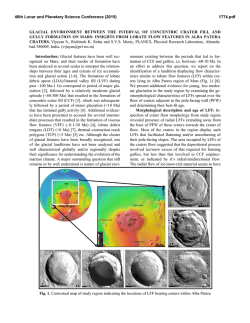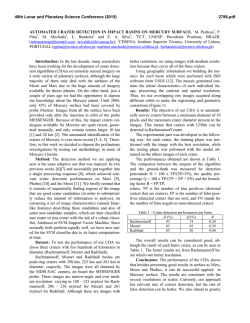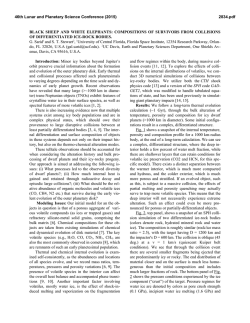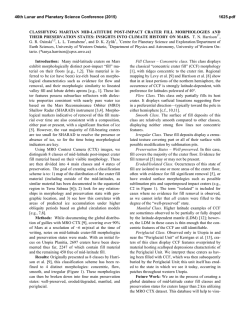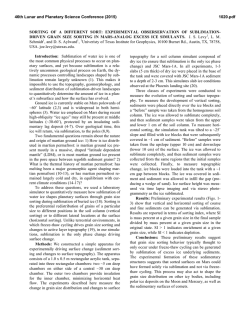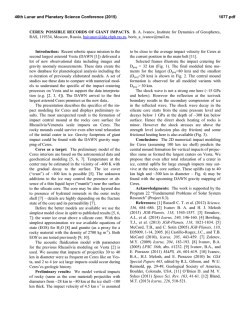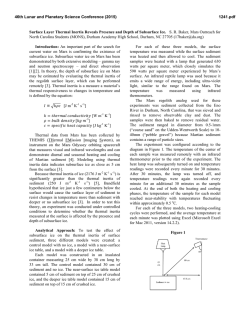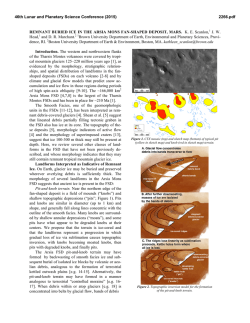
HYPERVELOCITY IMPACTS INTO MULTI
46th Lunar and Planetary Science Conference (2015) 1219.pdf HYPERVELOCITY IMPACTS INTO MULTI-LAYER TARGETS WITH AN ICE CRUST OVER A SATURATED SAND BASE. K. H. McDermott1, M. C. Cole1, M. J. Burchell1, 1School of Physical Sciences, University of Kent, Canterbury, UK, CT2 7NZ, [email protected] Introduction: The geological features on the surface of Europa and other icy satellites include: (1) large multi-ringed shallow impact craters such as Tyre, Callanish and Mananian, formed as a result of impact bodies between 2- 4 km in diameter [1] thought to have penetrated the ice crust; (2) chaos terrain characterised by broad areas where large blocks of original terrains occur in a structureless and hummocky matrix, with a texture that resembles detached ice bergs left to drift before the whole region refreezes. Currently these chaos areas are thought to be the result of internal heating causing melting of the ice crust in specific area, similar to a hot spot on the Earth’s surface [2]. An alternative idea is that these areas are the result of full crustal penetration causing the breakup of the surface producing the rafts of original ice terrain which are then refrozen in place once the external heat of the impact has dissipated. Therefore, chaos areas may be a hitherto unrecognised record of full-crustal penetration by an impactor [3]. By introducing a subsurface layer, be it fluid or solid, and varying the thickness of the ice surface and the impact speed, it may be possible to produce the range of geological features observed on Europa. Here we investigate variation in crater morphology as a direct result of ice crust thickness and subsurface density. Various ice crust thicknesses over a water saturated sand subsurface were produced for lab impact experiments, similar to the hydrocode modelling work previously reported by [4]. We report the crater morphology produced by impacts of 1.5 mm Al spheres at speeds of 1 - 5 km s-1 into targets of saturated sand with a surface crust of water ice of ~1, 2 and 3 cm thickness. Experimental method: The impact experiments were produced using the two stage light gas gun based at the University of Kent [5]. 1.5 mm Al spheres were loaded into a nylon discarding sabot and fired at the targets at a range of speeds from 1 – 5 kms-1. Each target was prepared so that the required ice thickness would be completely frozen with few blemishes and no cracks to act as weakened areas of the target. The ice formed downward from the open top of a cylinder of water, and the thickness required for each investigation was determined by varying the time interval the target remained within a -20OC environment. Results: <10 mm ice thickness: The impact into ice thickness between 8-10 mm resulted in complete penetration of the ice layer and formed short lived craters within the sand below at all impact speeds investigated (1 - 5 km s-1). The penetration left a bullet hole shape within the ice layer with an inclined edge to the crater. As the impact extended into the substrate saturated sand layer the wall slope of the temporary crater increases creating a deeper, narrower craters then that would be expected if the initial crater wall slope continued with in an the ice crust medium. The temporary crater within the saturated sand substrate is soon lost as the saturated sand flows to fill the excavated cavity. This is shown at all impact speeds with the higher speed impacts forming deeper temporary craters in the sand with a greater dip angle. 10 mm – 30 mm ice thickness: At an ice crustal thickness of 13 mm, a 3 kms-1 shot just penetrated the ice layer producing a bowl shaped extrusion of broken up ice into the soft saturated sand. The texture at the base of the crater was lumpy showing the base of the crater was made up of smaller rounded fragments of the ice. This rather fortuitous discovery demonstrates a snapshot into the cratering mechanism between two substrates with different densities at the point before complete penetration of the ice layer, which results in the loss of the ice that makes up the bowl shaped crater as it was displaced from the impact point. Such a feature was not repeated at other speeds. ≥ 30 mm Ice thickness: An ice thickness of 30 mm or more gave no penetration of the ice layer suggesting that the sand substrate below did not experience significant alteration as a result of the impact. The craters were rounded with many (> 6) radial fractures extending from the point of impact. Both the diameter and depth of the crater formed in this thickness of ice, increased with shot speed. There was no evidence of circular fractures forming during these impacts. Some of the ice around the target area spalled away, producing chips of ice which were ejected, producing an undulating surface around the crater edge. Solid ice (Standard): Ice only targets, 80 mm deep, were used as a standard for all impact speeds studied. The craters produced in these targets are similar to those reported previously [6, 7] and contain clear simple crater structures including numerous radial fractures that extended away from the point of impact, often forming numerous terraces as surface ice is chipped away during the impact. In addition to radial fractures, which penetrated down from the ice surface as well as away from the point of impact, the full ice targets at 3 kms-1 and 5 kms-1 and the 5 km s-1 impact into 50 mm ice, produced circular fractures up to 5 cm away from the point of impact. These fractures encompass the 46th Lunar and Planetary Science Conference (2015) whole crater and connect the radial fractures together. The circular fracture can be clearly observed, however such fractures often lie within the ice without reaching the surface and, as stated, are only observed within the full ice targets and the 5 kms-1 impact into 5 cm ice above water. This feature bears a resemblance to the rounded fractures observed as part of the larger of Europa’s craters such as Callenish crater, suggesting that this area of the Europa has a thick ice crust that was impacted without the pressure wave reaching a subsurface medium. However this feature was not observed in the solid ice target impacted at 1 kms-1 suggesting that such a feature is not wholly a result of homogenous medium thickness but also the impact speed. Discussion: The morphology of the craters produced in these experiments appears to vary with the thickness of the ice crust (Fig. 1a.). The largest diameter craters were constantly produced in the solid ice target at all shot speeds (Fig. 1b.). The craters that penetrated the ice layers produced the smallest diameter morphologies but with greatest depth as the projectile entered the softer subsurface material. The craters with the second largest mean diameter were produced in the ice with a thickness of 30 mm or more, followed by the 10-30 mm thickness ice. This shows that the large shallow craters represent areas of greater ice thickness, but whilst the diameter of the crater decreases with decreasing ice thickness the crater depth increases. A second crater morphology considered was the formation of fractures as a result of the impact. Very few fractures were observed in the ice layer penetrating shots. However this changed as the ice layer increased thickness. Firstly, we saw development of radial fractures that span away from the point of impact. These were readily observed in the craters from the 30 mm ice thickness upwards, however these craters lacked the circular fractures that were only observed as part of the craters that formed within the solid ice targets. These features are associated with a saturated sand subsurface layer, if a less dense/different material lay beneath the ice, it is believed a different morphology may occur. The changes in the morphology are linked to the transfer of the energy of the impact as a result of the density change between the two mediums. Therefore the presence of a subsurface ocean or solid homogeneous landmass would produce a distinct crater morphology if the pressure waves substantially interact with the subsurface layer before dissipation. From this initial work it is suggested that laboratory results indicate that the large shallow craters on Europa with larger circular faulting are present on the thickest ice regions (assuming an ice saturated sand base layer). The influence on crater size and shape of a sub-surface liquid ocean beneath the surface ice layer is considered 1219.pdf in a separate abstract (#1221) by the same authors also submitted to this meeting References: [1] Zahnle K. et al. (2002) Icarus 163, 263-289 [2] Ivanov M. et al. (2011) Advances in Space Research 48, 661-677 [3] Cox R. et al. (2008) MAPS 43, 2027-2048 [4] Bray V. et al. (2014) Icarus 231, 394-406 [5] Burchell M. et al. (1999) Measurement Science and Technology 10, 41-50 [6] Shrine N.R.G et al. (2002) Icarus 155, 475485 [7] Fendyke S. et al. (2013) Advances in Space Research 52, 705-714 a b Figure 1: (a) Mean crater diameter vs. ice thickness. (b) Mean crater diameter vs. impact speed. Ice thickness is given by: Circle – 80 mm, Square – 30 - 50 mm, Diamonds – 10 - 20 mm, Triangular – 1 - 10 mm,. Impact speed given by: Blue – 1 km s-1; Green – 3 km s-1 and Red – 5 km s-1. Error bars represent 1 σ standard deviation.
© Copyright 2025

